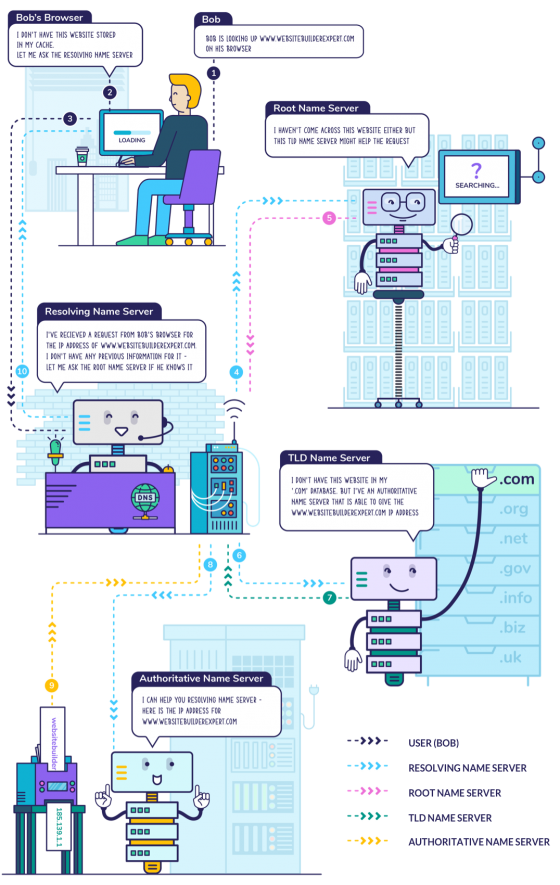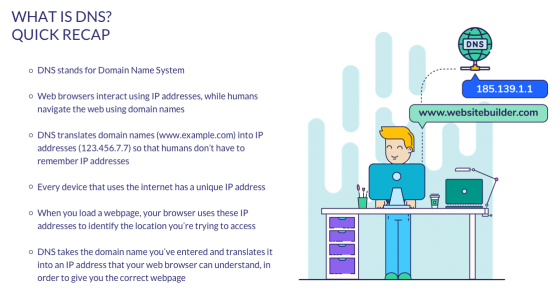At the end of August the Post and Telecommunications Regulatory Authority of Zimbabwe (POTRAZ), presented a draft Domain Name System (DNS) framework. This framework was a culmination of consultations the Regulatory body had with the public back in 2019.
Before we get into what the document says let’s break down the core elements of what DNS is.
What is a Domain Name System (DNS)?
So to break down what DNS is we have to start by looking at IP Addresses, and Domain Names:
IP (Internet Protocol) Address is an identifying number that is associated with a specific computer or computer network. When connected to the internet, the IP address allows computers to communicate with one another. IP Addresses are often represented as numbers in this format “123.456.7.8“. These numbers are what allow your web browser to locate a website. So you could, if you can remember the IP Address, type it into the address bar and then arrive at the website. But since it is difficult to remember every IP Address for every website we have domain names.
A Domain Name is a unique name that identifies a website. When you visit a website the domain name is in the address bar, this could be “google.com” or this website “techzim.co.zw”. It’s far easier to remember the name of the website you want to visit than to memorise the IP Address. So that we don’t have to memorise IP Addresses, web browsers translate the Domain Name we enter into the address bar into an IP Address.
An alternative way to view the relationship between IP Addresses and Domain Names is by looking at map coordinates and physical addresses. Every point on the earth has coordinates of longitude and latitude. If you are, for example, directing someone to your house it would be difficult for most people to make it there by giving them your coordinates. Even if they have Google Maps numbers aren’t always easy to process.
But it is easier to tell them, the name of the street and the house number. That would be far easier to enter into Google Maps than coordinates.
We finally arrive at DNS
Earlier there was mention of web browsers translating Domain Names into IP Addresses. Well, what allows your web browser to arrive at a website you type into the address bar is DNS.
Since computers are better suited to dealing with numbers and we are better suited to dealing with words. DNS is the intermediary between man and machine.
Servers and domains
The last two pieces to this puzzle are Domains and Domain Name Servers:
Domains are the letters that come at the end of the Domain Name. So if we use the example “www.google.com” the Domain is “.com”. There are different types of Domains but the two most common are:
- Generic Top-Level Domains or gTLD (“.com”, “.org”, “.net”, “.biz” and “.info”)
- Country code Top-Level Domains or ccTLD (“.zw”, “.uk”, “.za” etc )
In the example, we used earlier “google.com”, “.com” is an example of a gTLD (Generic Top-Level Domains).
Domain Name Servers are the ones that process a web address that you type in the address bar. There are four of them and they are:
- Resolving Name Server, this is the first server that makes the first step in the process. Its job is to query every server until it finds the correct IP Address. The most important thing it does is find the next server in the line which is called the Root Name Server.
- The Root Name Server is the first place that the Resolving name server comes to for a reference point. It tells the Resolving Name Server where to look for the correct TLD name Server (Top-Level Domain Server)
- TLD Name Server works with the registry of the last part of a domain name which can be “.org” or “.com”. When someone or an entity purchases a domain, the TLD registry updates the TLD name servers. This means that the TLD Name Server knows which Authoritative Name Server to refer to.
- The Authoritative Name Server is the final server in the chain. It then tells the first server in the chain, the Resolving Name Server, the IP Address the browser should go to in order for the user to get to the page they desire.
Website Builder Expert has a really good infographic that maps this process from start to finish.
















Comments
3 responses
Thank you for the article. Very informative.
a good read, you may also find it helpful to include other resource records, MX, SPF, TXT, CNAME, DKIM DMARC., PTR ..DNS is more than just where a domain points (A record)
expanding on the Internet Protocol (IPv4 and IPv6), and how IPv6 will change the traditional DNS model would also be informative.
This is great article! I learned a lot!